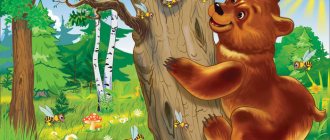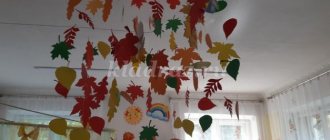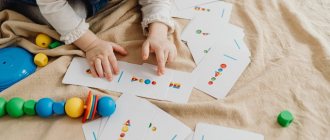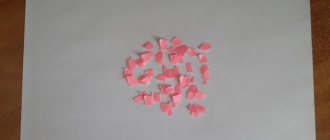What to choose?
Despite the fact that FGT and Federal State Educational Standards are two different quality standards that are used in different age categories, some kindergartens (especially private ones) may use certain teaching methods. Everyone knows the problems with queues for places in these institutions in our country, but if you have the opportunity to choose, what is better? No assessment can be objective. You just need to know that integrated classes in the first junior group, conducted according to the FGT system, will make your child an independent person who will harmoniously integrate into modern society. While GEF classes at such an early age can break your child, and as a result he will lose all desire to learn, which will lead to him becoming just another brick in the wall.
Example lesson
What exactly should kids do in kindergarten? Standards are not the most important thing. The process itself plays a decisive role in integrated lessons. Let's look at the situation using a clear example.
The first younger group is still just kids. They only learn to count, write, and study the world around them. And nothing but integrated classes will help them. You can start, for example, by combining mathematics, the Russian language and the surrounding world. Buy a special alphabet for preschoolers. It will be depicted on a large Whatman paper, next to it there will be beautiful pictures of animals, trees and other objects that surround us. Moreover, the number of, for example, elephants near the letter “C”, kittens near “K” (and so on) will be different. Now start learning the alphabet with your kids by asking who is in the picture and in what quantities. If difficulties arise, please help. By going through the entire alphabet, you will help children get used to counting. Plus, kids will learn to call the things around us by their proper names, practice their fragile speech, and also develop reading and Russian language skills. This approach (combining mathematics, the outside world and speech development) is very popular. Usually, teachers read fairy tales with children and, showing pictures, ask the children to describe the picture that is happening and count everything that is shown in the picture.
General requirements
According to federal and state education standards, there are no specific requirements for conducting classes. For the most part, they are advisory in nature.
- Interaction between teacher and student. This implies continuous contact between the child and the preschool employee. You cannot give your children a task (for example, make a craft from plasticine) and go watch your favorite series on TV. It is necessary to control the creative process.
- Most learning should be done through play. It is clear that such activities need to be prepared in advance, and kindergarten employees have a small salary to spend time at home on organizing events, but at least occasionally give the children an adventure.
- Gender approach. Foster in children a sense of equality between the sexes. If boys have to do physical exercises, then the female half of the students too, if you keep the girls busy with needlework, then put the boys in similar work.
- Versatility. The development of children should be comprehensive, so that by the time they leave school they have an understanding of different areas of life and can independently choose the path of interest; this is why integrated classes are needed in the first junior group. Be it an artist, a builder, a businessman or an electrician.
- Unity. All students upon graduation from preschool educational institutions must have the same skills. An educator cannot teach only a select few, guided by subjective opinion. Everyone should have equal opportunities when entering school.
Summary of an integrated lesson in the first junior group: “Merry droplets”
Summary of an integrated lesson in the first junior group:
“Happy Droplets”
Educator: Svetlana Egorovna Paskevich
Mini-
Target:
- Introduce children to the properties of water: warm, clear, cold, clean, dirty.
- Bring kids to the understanding that plants, fish, birds, animals and humans cannot live without water.
- Introduce the non-traditional fine art technique of finger painting. Show techniques for obtaining points and short lines. Learn to draw rain, conveying its character (small droplets, heavy rain), using dots and lines as a means of expression. Show interest in drawing.
- Give children emotional pleasure from communicating with each other and playing with water.
Preliminary work:
Conversation about water.
Looking at illustrations, reading nursery rhymes and poems. Materials:
bowls of water, trays, sponges for each child, blue gouache in bowls, napkins, an umbrella for playing, a landscape sheet on which the baby is drawn.
Lesson plan:
1. A fairy tale about a small drop.
2. “P/i “Sun and Rain”
3.Drawing “Rain” in an unconventional way.
4. Playing with water: “Cloud and droplets.”
5. Physical school
Progress of the lesson:
Educator:
Now, children, I’ll tell you a fairy tale - about a small drop.
Want to? Children:
Yes!
Educator:
Then listen.
- Once upon a time there was a small drop. Where there was a drop, there was water. And where there was water, everyone felt good. The fish were happy to swim in the water, the plants and flowers were happy to grow. And you and I can swim and drink water. But then trouble happened. A strong wind came and brought frost, a droplet froze. And without a drop, fish, flowers and birds will die. We need to save a little bit. Let's call Sunny for help. It is warm, bright, and will warm up a little. Children: name is Sunny.
Sunny, respond!
Red, appear! The Sun appears. Sunny:
Hello kids!
Why did they call me, little friends? Or what trouble happened? Educator:
Sunny!
The frost froze a little. Help us get her back, please. Birds, fish, plants, people cannot live without water. Sunny:
I'll help you!
I will disperse the wind and return your drop. The sun dances, spins, and a droplet appears.
Droplet
appears Hello guys.
I am a drop of water, you really need me, I’ll drip, I’ll drip, and I’ll get water. Do you know how I drip? Children:
Yes!
Drip, Drip, Drip... Educator:
Guys, let's play a game.
The outdoor game “Sun and Rain” (lyrics by A. Barto) is played. Children walk around, clap their hands, stamping their feet to the text: The sun is looking through the window, Shining into our room. We clapped our hands, We are very happy about the sun! At the signal “It’s raining, hurry home!” everyone runs and hides under an umbrella held by an adult. Droplet:
Very interesting game!
How fun and good I feel with you. Do you guys know how to draw rain? Children:
Yes!
Children draw “Rain” using an unconventional fine art technique of finger painting.
Rain, rain, have fun!
Drip, drip, don't be sorry! Just don't kill us! Don't knock on the window in vain. Droplet:
Guys, do you want to play with water?
Children:
Yes!
is played with water : “Cloud and droplets.” Children approach the tables on which there are trays with sponges, glasses with cold and warm, clear and colored water, and basins. Educator:
What is on the tray?
(children's answers). What do you think a sponge looks like? (children's answers). That's right, she looks like a cloud, like a cloud. A cloud consists of droplets. Squeeze it and see if water flows from the cloud or not? What kind of water flows from the cloud, warm, clean or cold and dirty? (children's answers). Children take a sponge - a cloud and squeeze it in their hand. Droplet
: Guys, are you probably tired?
Let's do some exercises! Physical school Oh, okay, okay,
(show your palms, twirl your hands up and down)
We are not afraid of water,
(stomp one foot)
We wash ourselves clean,
(smooth circular movements with our hands near our face)
We smile at mom.
(spread your arms wide and smile)
Droplet
: It was so interesting for me to be with you.
I really don’t want to leave, but I have to go. Goodbye guys, see you. Children
: Goodbye, Droplet.
Federal State Requirements
At the same time, these requirements are aimed at achieving several other goals. Integrated classes in the first junior group on FGT should be conducted according to the following principles:
- Teaching cultural and historical values.
- Activity-personal approach.
- Development of intelligence and physical culture.
- Formation of desire and desire for learning in preschool children.
- Formation of a general culture of behavior in a child.
- Education does not hammer facts into children's heads, but develops and scientifically substantiates them.
- The unity and importance of all the tasks that a teacher faces: education, development, training.
- Joint and independent classes.
- As a result of mastering the program, the child acquires various qualities.
Thus, integrated classes in the first junior group of kindergarten in FGT come down to the formation of an individual who will join modern society and behave like everyone else, but at the same time retain his individuality and difference from others.





